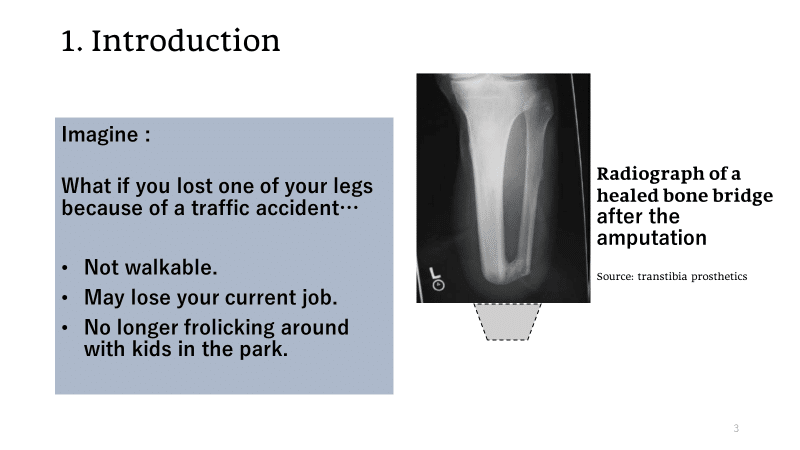
医療器具分野における3D技術の応用と社会包摂
Good morning, esteemed guests and colleagues. Today, I would like to address a pressing issue that is often overlooked.
Our focus will be on amputees who have lost limbs and their place within our society.


You would struggle to walk, potentially lose your job, and no longer be able to actively play with your children in the park. It is crucial to acknowledge the vital role prosthetics and orthotics play in empowering individuals with physical impairments, allowing them to lead independent, dignified lives and actively participate in society. However, limited access to these devices can result in social exclusion, isolation, and poverty, which in turn exacerbate the burden of morbidity and disability.

Approximately 40 million people worldwide lack access to prosthetic legs. Of these individuals, 90% cannot afford prosthetics or are unaware of available services. Alarmingly, the number of amputees is expected to reach 80 million, affecting 1 in 100 people globally.
Now, you see that this is called the global amputee crisis.

● Reduce the number of new amputees to less than 1 million people.
● Ensure all individuals requiring prosthetic devices can obtain them.
●*Enable all amputees using prosthetics to experience a healthier and happier life without exception.

Limb loss often results in unemployment, financial dependence, and social exclusion.


In contrast, 3D-printed prosthetics, shown on the right, use AI and 3D scanning for efficient, precise, and customizable designs.


By working with local partners, we can help amputees regain their dignity and integrate into society.

Effective communication among fitters, users, and clinics are also critical for fine-tuning the socket and liner, ultimately contributing to improved patient quality of life

Social inclusion is essential for amputees to lead dignified lives.
Without respectful inclusion, functional gains from prosthetics do not translate into an improved quality of life.
Exclusion, dependence, and isolation have significant social and economic consequences that we must address.
Emphasizing social inclusion ensures that personal quality of life aligns with overall social well-being.

● Reduce new amputees by promoting healthy lifestyles, research, and collaboration.
● Ensure every amputee has access to prosthetics through holistic care, innovation, and strong networks.
● Achieve 100% social inclusion and dignified living by addressing misconceptions, advocating policies, and empowering amputees. Your support is crucial in making these goals a reality.

Please join and let's work together to build better society involving amputees worldwide.
この記事が気に入ったらサポートをしてみませんか?
